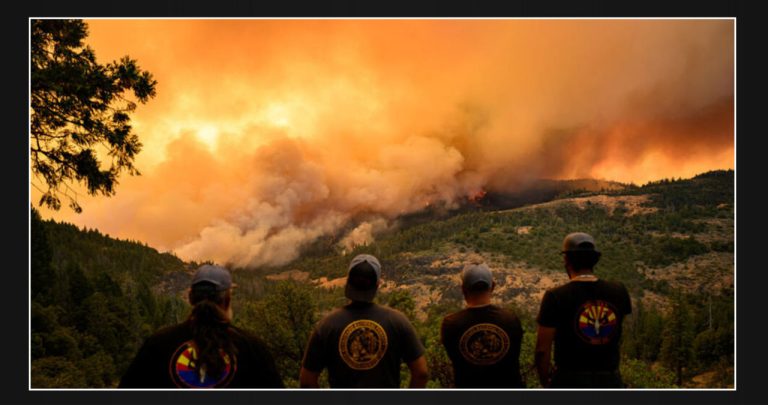The National Weather Service issued a report on Thursday at 10:17 p.m. warning about strong thunderstorms in Montgomery and Pike counties. The alert was in effect until 11 p.m.
Residents could potentially experience wind gusts reaching speeds of up to 40 mph.
The weather service reported that strong thunderstorms were detected by Doppler radar at 10:17 p.m. The storms were moving southeast at a speed of 50 mph and were observed along a line from near Shopton to Ramer. They warned that gusty winds could potentially cause damage by knocking down tree limbs and blowing around unsecured objects.
The alert has affected various areas, including Troy, Brundidge, Goshen, Banks, Pine Level, Dublin, Linwood, Grady, Ramer, Kent, Strata, Naftel, Antioch, Ansley, Troy Municipal Airport, Troy University, Josie, Currys, Hamilton Crossroads, and Monticello.
The weather service advises individuals to seek shelter indoors if they are outdoors. They also mentioned that a Severe Thunderstorm Watch is still in effect until 11 p.m. for south central and southeastern Alabama.
Preparing for approaching lightning: Expert safety advice
Every summer, the United States experiences around 25 million lightning strikes, posing a significant threat to people and property. Tragically, about 20 lives are lost each year due to these electrifying events, according to the weather service. The danger of lightning is at its highest when thunderstorms are nearby, peaking when the storm is directly overhead and diminishing as it moves further away.
Here are some important tips to keep in mind to ensure your safety during a thunderstorm:
1. Creating a Lightning Safety Plan:
Having a well-designed lightning safety plan in place is crucial to ensure the safety of individuals and the protection of property.
-
- When venturing outdoors, it’s crucial to have a lightning safety plan in place.
- Stay vigilant by monitoring the sky for ominous signs and listening for the telltale sound of thunder. If thunder is audible, it’s a clear indication of nearby lightning.
- Seek a safe place to shelter, preferably indoors.
2. Ensuring Safety Indoors:
When it comes to maintaining a safe environment indoors, there are several measures that should be taken into consideration. These precautions are vital in order to protect yourself and those around you. Here are some important steps to follow:
– Keep the indoor space well-ventilated: Proper ventilation is crucial in reducing the risk of airborne transmission of viruses and other contaminants. Open windows and use fans to promote air circulation.
– Practice regular hand hygiene: Wash your hands frequently with soap and water for at least 20 seconds. If soap and water are not available, use hand sanitizers with at least 60% alcohol content.
– Maintain social distancing: Keep a distance of at least 6 feet from others who are not part of your household. Avoid crowded places and close contact with individuals who are sick.
– Wear a mask: Cover your nose and mouth with a mask or face covering when you are in public settings where social distancing is challenging to maintain. This includes indoor spaces such as grocery stores, pharmacies, and public transportation.
– Clean and disinfect frequently touched surfaces: Regularly clean and disinfect high-touch surfaces such as doorknobs, light switches, countertops, and electronics. Use EPA-approved disinfectants and follow the instructions on the label.
– Stay home if you’re feeling unwell: If you have symptoms of illness or have been in contact with someone who has tested positive for COVID-19, it is important to stay home and avoid close contact with others.
By following these indoor safety measures, you can greatly reduce the risk of viral transmission and ensure a safer environment for everyone.
-
- Once you’re indoors, avoid using corded phones, electrical devices, plumbing fixtures, and stay away from windows and doors.
- Lightning can follow conductive pathways, and these precautions reduce the risk of electrical surges.
3. Wait for the all-clear: Before proceeding, it is crucial to wait for the all-clear signal. This ensures that it is safe to move forward and take the next steps. It is important not to rush or act impulsively, as this can lead to unnecessary risks or complications. Take the time to gather all the necessary information and wait for the appropriate guidance before making any decisions. Trust the process and follow the instructions provided to ensure a smooth and successful outcome.
-
- After the last lightning strike or thunderclap, wait at least 30 minutes before resuming outdoor activities.
- It’s important to remember that lightning can strike even when a storm seems to have passed, so exercise caution.
If you find yourself in a situation where you don’t have access to indoor shelter, it’s important to take certain steps to ensure your safety and well-being.
When you are caught outside during a thunderstorm without any indoor shelter, there are a few steps you can take to ensure your safety:
1. Find a Low-Lying Area: Look for a low-lying area away from trees, water bodies, and metal objects. Avoid open fields and hilltops, as they are more prone to lightning strikes.
2. Crouch Down: Once you have found a suitable location, crouch down on the balls of your feet. This will minimize your contact with the ground and reduce the risk of a direct lightning strike.
3. Keep Your Distance: Make sure to keep a safe distance from other people to minimize the risk of side flashes, which occur when lightning strikes a nearby object and jumps to a person.
4. Avoid Metal Objects: Stay away from metal objects such as fences, poles, and umbrellas. These can attract lightning and increase your chances of getting struck.
5. Don’t Seek Shelter Under Trees: Contrary to popular belief, seeking shelter under a tree is not safe during a thunderstorm. Trees can attract lightning and pose a significant risk.
6. Stay Away from Water: Avoid bodies of water, including lakes, ponds, and swimming pools. Water is an excellent conductor of electricity, and being in or near it during a storm increases your chances of being struck by lightning.
7. Wait It Out: If possible, wait for the storm to pass before venturing out again. Thunderstorms can be unpredictable, and it’s best to stay in a safe location until the threat has subsided.
Remember, being caught outside during a thunderstorm can be dangerous, so always prioritize your safety and take these precautions to minimize the risk of lightning-related incidents.
-
- Avoid open fields, hilltops, or ridge crests, which expose you to greater lightning risk.
- Steer clear of tall, isolated trees and other prominent objects. In forested areas, stay close to lower stands of trees.
- If you’re with a group, ensure individuals are spread out to prevent lightning current from transferring between people.
- Camping in an open setting during a thunderstorm is strongly discouraged. If no alternative exists, set up camp in a valley, ravine, or other low-lying areas. Remember that a tent offers no protection against lightning.
- Do not approach water bodies, wet objects, or metal items. Although water and metal do not attract lightning, they conduct electricity effectively and can pose significant risks.
When it comes to the threat of lightning, it is important to remain vigilant and prepared. By adhering to these guidelines, you can greatly decrease the likelihood of accidents caused by lightning and prioritize your personal safety.
Navigating rainy roads: Safety tips for wet weather
During heavy rainfall, it is important to stay informed and follow the tips provided by the weather service to ensure road safety. Rain can transform roads into hazardous conditions, so it is crucial to take necessary precautions.
Keep an eye out for swollen waterways.
-
- Avoid parking or walking in close proximity to culverts or drainage ditches, as the swiftly moving water during heavy rain can potentially carry you away.
Maintain safe driving distances.
-
- The two-second rule for following distance is your ally in heavy rain. Extend it to four seconds to ensure safe spacing in adverse conditions.
Slow down and remain cautious.
-
- On wet roads, reducing your speed is crucial. Ease off the gas pedal gradually and avoid abrupt braking to prevent skidding.
Choose your lane wisely:
-
- Stay toward the middle lanes – water tends to pool in the outside lanes.
Make visibility a top priority.
-
- Enhance your visibility in heavy rain by activating your headlights. Be particularly vigilant for vehicles in blind spots, as rain-smeared windows can obscure them.
Be cautious of slippery roads.
-
- The first half-hour of rain is when roads are slickest due to a mix of rain, grime, and oil. Exercise heightened caution during this period.
Stay at a safe distance from large vehicles:
-
- Large trucks and buses can reduce your visibility with tire spray. Avoid tailgating and pass them swiftly and safely.
Mind your windshield wipers:
-
- Overloaded wiper blades can hinder visibility. If rain severely limits your sight, pull over and wait for conditions to improve. Seek refuge at rest areas or protected spots.
- If the roadside is your only option, pull off as far as possible, preferably past the end of a guard rail, and wait until the storm passes. Keep your headlights on and turn on emergency flashers to alert other drivers of your position.
To ensure your safety and well-being during heavy rain, it is important to follow these safety measures. Stay updated about weather conditions and listen to the advice given by local authorities. This will help you have a safe and secure journey.
United Robots offers a service called Advance Local Weather Alerts, which utilizes machine learning to aggregate the most up-to-date information from the National Weather Service.



